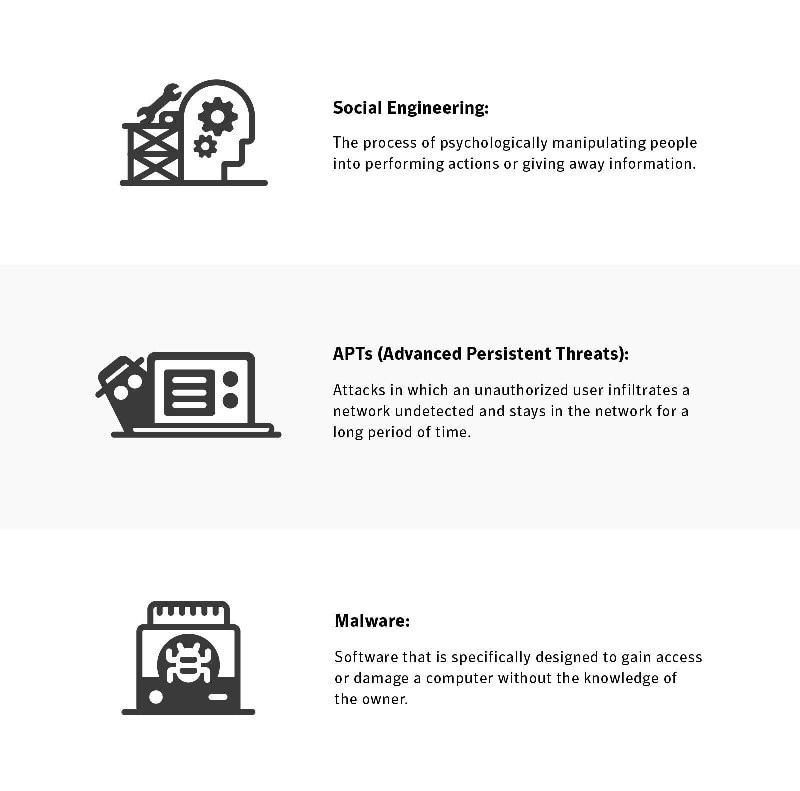You’ll learn more about cyber security and how to help defend yourself against cyber threats. It could help you recognize and avoid threats before they’re able to infiltrate your network or device.
Types of cyber threats
There are many types of cyber threats that can attack your devices and networks, but they generally fall into three categories. The categories are attacks on confidentiality, integrity, and availability.1
- Attacks on confidentiality. These include stealing your personal identifying information and your bank account or credit card information. Many attackers will take your information and sell it on the dark web for others to purchase and use.
- Attacks on integrity. These attacks consist of personal or enterprise sabotage and are often called leaks. A cybercriminal will access and release sensitive information for the purpose of exposing the data and influencing the public to lose trust in that organization.
- Attacks on availability. The aim of this type of cyberattack is to block users from accessing their own data until they pay a fee or ransom. Typically, a cybercriminal will infiltrate your network and block you from accessing important data, demanding that you pay a ransom. Companies sometimes pay the ransom and fix the cyber vulnerability afterward so that they can avoid halting business activities.
Here are a few types of cyber threats that fall into the three categories listed above:
Social engineering, a type of attack on confidentiality, is the process of psychologically manipulating people into performing actions or giving away information. Phishing attacks are the most common form of social engineering. Phishing attacks usually come in the form of a deceptive email that tricks the user into giving away personal information.
APTs (Advanced Persistent Threats), a type of attack on integrity, are attacks where an unauthorized user infiltrates a network undetected and stays in the network for a long time. The intent of an APT is to steal data and not harm the network. APTs happen most often in sectors with high-value information, such as national defense, manufacturing, and the finance industry.
Malware, or malicious software, is a type of attack on availability. It refers to software that is designed to gain access to or damage a computer without the knowledge of the owner. Several common types of malware include spyware, keyloggers, true viruses, and worms.
How to help protect against cyber security attacks

Follow these steps for cyber safety.
- Only use trusted sites when providing your personal information. A good rule of thumb is to check the URL. If the site includes “HTTPS://,” then it’s a secure site. If the URL includes “HTTP://,” — note the missing “s” — avoid entering sensitive information like your credit card data or Social Security number.
- Don’t open email attachments or click links in emails from unknown sources. One of the most common ways people are attacked is through emails disguised as being sent by someone you trust.
- Always keep your devices updated. Software updates contain important patches to fix security issues. Cyber attackers thrive on outdated devices because they don’t have the most current security software.
- Back up your files regularly to prevent cyber security attacks. If you need to wipe your device clean due to a cyberattack, it will help to have your files stored in a safe, separate place. Cyber security is constantly evolving, which can make it difficult to stay up to date. Staying informed and being cautious online are two of the best ways to help protect yourself and your business. To learn more about cyber security, visit our emerging threats center for the latest cyber security news.
Why is cyber security important?
In today’s connected world, everyone benefits from advanced cyberdefense programs. At an individual level, a cyber security attack can result in everything from identity theft, to extortion attempts, to the loss of important data like family photos. Everyone relies on critical infrastructures like power plants, hospitals, and financial service companies. Securing these and other organizations is essential to keeping our society functioning.
- Everyone also benefits from the work of cyber threat researchers, like the team of 250 threat researchers at Talos, who investigate new and emerging threats and cyber attack strategies. They reveal new vulnerabilities, educate the public on the importance of cyber security, and strengthen open-source tools. Their work makes the Internet safer for everyone.
CHALLENGES OF CYBER SECURITY
For effective cybersecurity, an organization needs to coordinate its efforts throughout its entire information system. Elements of cyber encompass all of the following:
- Network security
- Application security
- Endpoint security
- Data security
- Identity management
- Database and infrastructure security
- Cloud Security
- Mobile security
- Disaster recovery/business continuity planning
- End-user education
The most difficult challenge in cyber security is the ever-evolving nature of security risks themselves. Traditionally, organizations and the government have focused most of their cyber security resources on perimeter security to protect only their most crucial system components and defend against known threats.
Today, this approach is insufficient, as the threats advance and change more quickly than organizations can keep up with. As a result, advisory organizations promote more proactive and adaptive approaches to cyber security. Similarly, the National Institute of Standards and Technology (NIST) issued guidelines in its risk assessment framework that recommend a shift toward continuous monitoring and real-time assessments, a data-focused approach to security as opposed to the traditional perimeter-based model.
Also Read:
Related:-Is Quantum Computing The Future Explained 2022
Related:- What Is Blockchain Technology? How will Blockchain Work? 2020
Related:-How IOT AND AI can be used to replace manpower in agriculture 2020
Follow Startupcolleges on Facebook, Instagram, and Twitter, for the latest updates from the startup ecosystem. Subscribe to our YouTube Channel for more entrepreneurship, business, and corporate solution video
